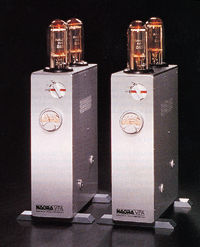| Columns Retired Columns & Blogs |
Nagra VPA monoblock power amplifier
Nagra's VPA amplification system consists of two slim, handsome monoblock amplifiers intended for vertical placement. They look good adjacent to the speakers. However, two 845 tubes put out a lot of heat, so the amplifier should be at least a foot away from your speakers...unless you're looking for a nice crackle finish.
Footnote 1: Protect the tubes and damn the flesh. Tres audiophilique!
 The chunky 845s sit bravely atop the casework, one in front of the other, and therein lies a brief tale. A pair of "mandatory optional" tube protectors is now supplied with every VPA. These can be returned through the dealer for a $1200 rebate, provided you sign a document absolving Nagra of all responsibility for damages resulting from exposed, sizzling-hot tubes. I was shown the highly polished protectors (footnote 1) at the January '99 CES, and found them elegant, sculptural, and clearly effective at keeping soft tissue away from hot glass. And 845s run in excess of 535 degrees F! For the record: no kids, no pets, so no protection chez 10.
The chunky 845s sit bravely atop the casework, one in front of the other, and therein lies a brief tale. A pair of "mandatory optional" tube protectors is now supplied with every VPA. These can be returned through the dealer for a $1200 rebate, provided you sign a document absolving Nagra of all responsibility for damages resulting from exposed, sizzling-hot tubes. I was shown the highly polished protectors (footnote 1) at the January '99 CES, and found them elegant, sculptural, and clearly effective at keeping soft tissue away from hot glass. And 845s run in excess of 535 degrees F! For the record: no kids, no pets, so no protection chez 10.
The manual also warns that the VPA operates with extremely high internal voltages that sometimes exceed 1200V: "Such voltages can KILL you!" There follows more colorful language, and dire warnings regarding tube sockets that carry 600V even several minutes after the power is shut off. And the storage capacitors don't fully discharge for two hours beyond that. To provide an additional margin of safety, Nagra has wired the VPA so that removal of either side panel disconnects the power as well. (The whole design reeks of Swiss competence.) I'm not being sensationalist about this. Respect the VPA as the hot-running, high-voltage device it is and It Will Provide. Cold-nosed pets and curious little fingers have no business around these Swiss Guards of quality sound engineering.
The tubes are hand-selected, thoroughly inspected, and tested. The enclosure is made of CNC-machined, hardened aluminum. Nagra claims that a circuit topology fully balanced from input to output makes for lower distortion and intermodulation, and better rise-time characteristics. "Special" toroidal transformers "provide full power output even at very low frequencies, with excellent performance irrespective of the type of loudspeaker impedance loading." For which there are one "cold" gold-plated WBT speaker binding post and three "hot" posts to choose from: for 4, 8, or 16 ohm loads.
Setup and Tube Topics, or Is that 845 loaded?
Setting up the VPAs was a breeze. It took just a few minutes to mount the footers and insert the chunky 845s into their sockets—a locating pin on the base of each tube bayonets into the huge receptacle with a slight push and a quarter turn to the right. Each tube's serial number is keyed to the VPA it's meant for, and marked for front or rear placement. The owner is advised to wear the provided cotton glove when handling the tubes to avoid leaving grease spots on the glass. Your bio-smear can affect the expansion rate of the glass envelope, and even cause it to crack or explode. (Didn't know you were so potent, did you?) And once your sticky fingerprint is on the tube, it can't be removed after they've heated up and annealed the evidence in place. So think Swiss: Be fastidious.
Fit a power cord into the main power switch/fuse-holder/IEC receptacle and a balanced interconnect (or single-ended with the provided adapters), and you're ready for business...once you've selected the appropriate binding post. Ah, but which one? Actually, Nagra takes the guesswork out of it with a terrific feature they call the Load Match Meter. It sits on the front panel just below the main rotary selector switch, resembling the multi-function modulometer found on Nagra's PL-P preamp.
The Load Match Meter is used to check for correct tube operation, set bias, and dial in the speaker's impedance load. The meter's red pointer indicates peak cathode current on the output tube; the black one shows peak anode voltage. A small switch inside the case selects the tube you're "looking" at, and there's a potentiometer to set the bias, if necessary. A small green zone on the meter's left indicates correct current and voltage tube setting. When the amp is powered up and in mute, both pointers should land in the green. If they don't, check that the tubes are mounted correctly front and back, as indicated by the F and R suffixes in the serial numbers.
Footnote 1: Protect the tubes and damn the flesh. Tres audiophilique!
- Log in or register to post comments



































